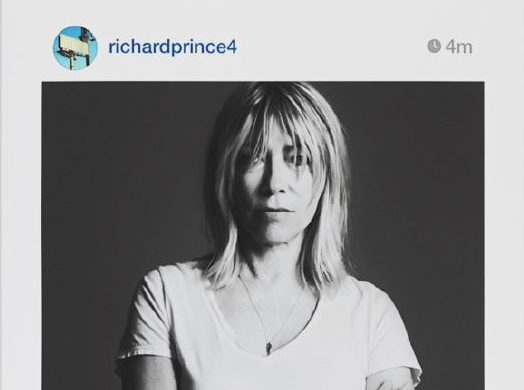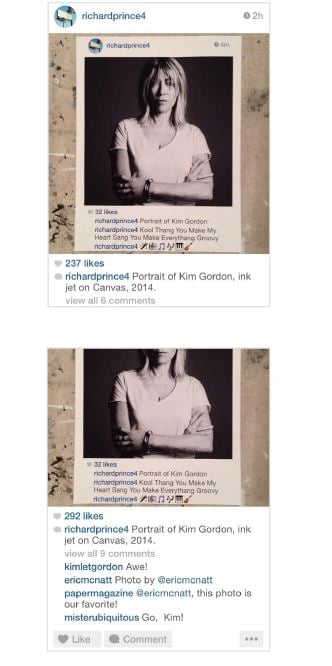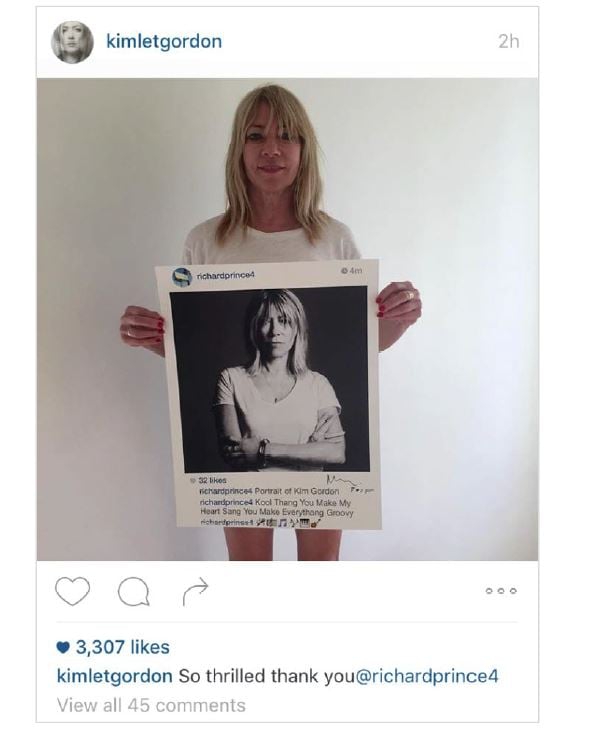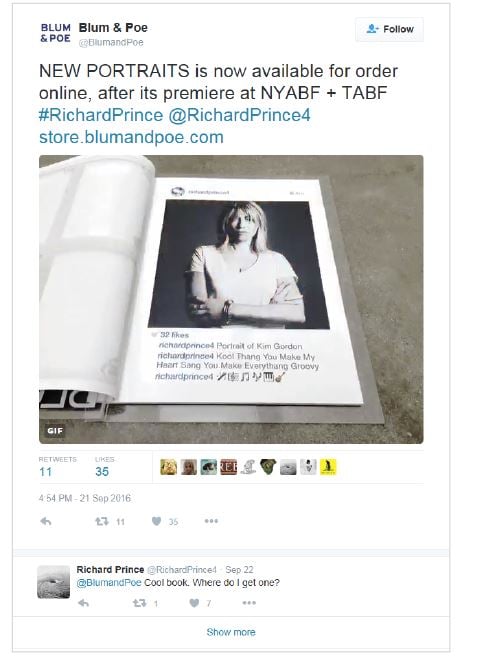Law & Politics
Richard Prince Slapped With Yet Another Copyright Lawsuit
The hits keep coming, but Prince doesn't seem to care.

The hits keep coming, but Prince doesn't seem to care.

Eileen Kinsella

Contemporary art star and appropriation artist Richard Prince has been hit with the latest in a string of copyright infringement lawsuits, this one brought by professional photographer Eric McNatt over Prince’s use of an image he took of former Sonic Youth leader Kim Gordon.

Instagram posts attached as exhibits to the lawsuit include this post by Richard Prince of a since-deleted account.
Also named as defendants in the suit, which was filed November 16 in US District Court, Southern District of New York, are Blum & Poe Gallery, and Ocula Limited, an online art magazine and marketplace that displays work for sale.
McNatt’s suit outlines how he photographed Gordon for Paper magazine in July 2014 at her home in Northampton, Massachusetts, including six hours spent traveling to and from Northampton and about three hours spent setting up the shoot. The photo, which McNatt copyrighted, was first published in September 2014 as part of Paper‘s 30th anniversary edition, online and in print, and on an Instagram account controlled by Paper.

Instagram posts attached as exhibits to the lawsuit include this post by Kim Gordon holding Prince’s signed inkjet portrait of her.
McNatt licensed the photo to Vogue.com for one time use in February 2015, and he published digital copies on his website and related social media platforms, including Tumblr and Instagram. He also included authorship information as well as a copyright symbol.
In September 2014, McNatt’s complaint alleges, Prince created and displayed the infringing post on his Instagram account “@richardprince4” with “an exact reproduction” of the copyrighted photo, “the only modification being minor cropping of the bottom and top portions.” Several lines of text under the Instagram post, written by Prince, read: “Portrait of Kim Gordon,” and “Kool Thang You Make My Heart Sang You Make Everything Groovy,” followed by a line of emojis depicting musical notation and instruments.

Instagram posts attached as exhibits to the lawsuit include a Blum and Poe photo of the portraits book,
The complaint says Kool Thang was the title of Sonic Youth’s first album, and that the line is a riff on the song “Wild Thing,” written by Chip Taylor. The Sonic Youth song, which is actually titled “Kool Thing,” is from the band’s 1990 album “Goo.”
For those of you who reside under a rock, the complaint provides this helpful information: “Instagram is a social media platform, owned by Facebook, Inc., described on its Internet website as a ‘fun and quirky way to share your life with friends through a series of pictures.'”
The complaint says Prince’s infringing portrait is “an inkjet print on canvas” that includes “an exact reproduction of” the photo. To create the work, Prince “accessed and copied the Copyrighted Photograph from Paper‘s website or Instagram account, published his copy of the Copyrighted Photo to his own Instagram account, added the Appended Text ,” took a screen shot, sent the image to a computer, and then printed the image as an inkjet on canvas.
Later that month, Prince posted another Instagram picture of the infringing portrait with the caption noting it was an “inkjet on canvas,” prompting Gordon herself, whose Instagram account is “kimletgordon” to comment: “Awe!”
McNatt’s complaint says several Instagram account holders posted comments to Prince’s post noting that the Infringing Portrait incorporated a copy of McNatt’s work including comments from McNatt’s own account as well as that of Paper magazine. Subsequently Prince deleted the richardprince4 account, the complaint states, though that handle is still active on Twitter.
In Spring 2015, Blum & Poe’s Tokyo branch held a solo Prince exhibition that included a series of 16 inkjet prints, including the Gordon image in question. Concurrently Ocula published a copy of the work on its website, and it provided a service “through which visitors of the website could request pricing and availability” of the work from Blum & Poe. The gallery also published a book for the exhibition, which is referred to in the court documents as “The Infringing Book.”
In February 2016, the complaint notes, Gordon posted a photo to Instagram, showing her “holding a copy of the Infringing Portrait signed by Mr. Prince” with the comment, “So thrilled thank you @richardprince4.” The complaint outlines a number of other instances of the book’s promotion, including the recent New York Art Book Fair, at MoMA PS1. amd at the Tokyo Art Book Fair, also held this past September.
“None of Mr. Prince, Blum & Poe or Ocula ever solicited or obtained permission from McNatt to reproduce, modify, distribute, or display the Copyrighted Photograph or prepare any derivative work therefrom,” according to the suit.
The complaint outlines at length Prince’s brazen attitude towards appropriating works, and his disposition toward previous legal actions against him, including the case brought by photographer Patrick Cariou. In that case, which dragged on for years, and resulted in a partial ruling against Prince that was then overturned, Cariou alleged that Prince inappropriately incorporated images from his “Yes Rasta” photograph series, documenting Rastafarians in the mountains of Jamaica into his “Canal Zone” series, a body of work that was shown at Gagosian Gallery in 2008.
Writing in the artlawblog this morning, under the headline “Deja Vu All Over Again,” attorney Donn Zaretsky said: “This is why I called the Second Circuit’s Prince-Cariou decision a ‘missed opportunity.’ Nobody has any idea what’s fair use and what’s not in the fine art context. Prince-Cariou could have helped clear that up; instead, it made things worse.”
Indeed, among the exhibits to McNatt’s suit are two sets of examples of Prince’s work that incorporated Cariou’s imagery; those that the court found to be fair use and those that it didn’t.
In 2011, the McNatt complaint notes: “Prince commented ‘Copyright has never interested me. For most of my life I owned half a stereo, so there was no point in suing me, but that’s changed now and it’s interesting […] So, sometimes it’s better not to be successful and well known and you can get away with much more. I knew what I was stealing 30 years ago, but it didn’t matter because no one cared, no one was paying any attention.”
In the same interview, Prince talked about the notion that “the court had become an extension of his artistic expression. He also said the Canal Zone controversy had had a positive impact on the body of works.
It mentions his retweet in 2016 of a tweet by @Plantwerk that read: “RichardPrince4 on being cool, cracking-up.shit-stirring.asshole judges.Flip-flop.narcissism/democracy of Instagram” with a link to an article on Vulture.com describing Prince’s unapologetic approach to taking images.
The complaint does not specify damages, but its claims for relief include copyright infringement against Prince for the photograph and the book; copyright infringement against Blum & Poe; infringement against Ocula; a declaration that Prince’s use of the Gordon portrait in his work and in the book does not constitute fair use; and a request for “ordering the destruction, or other disposition as the court deems appropriate” of the Prince work and related books in question.